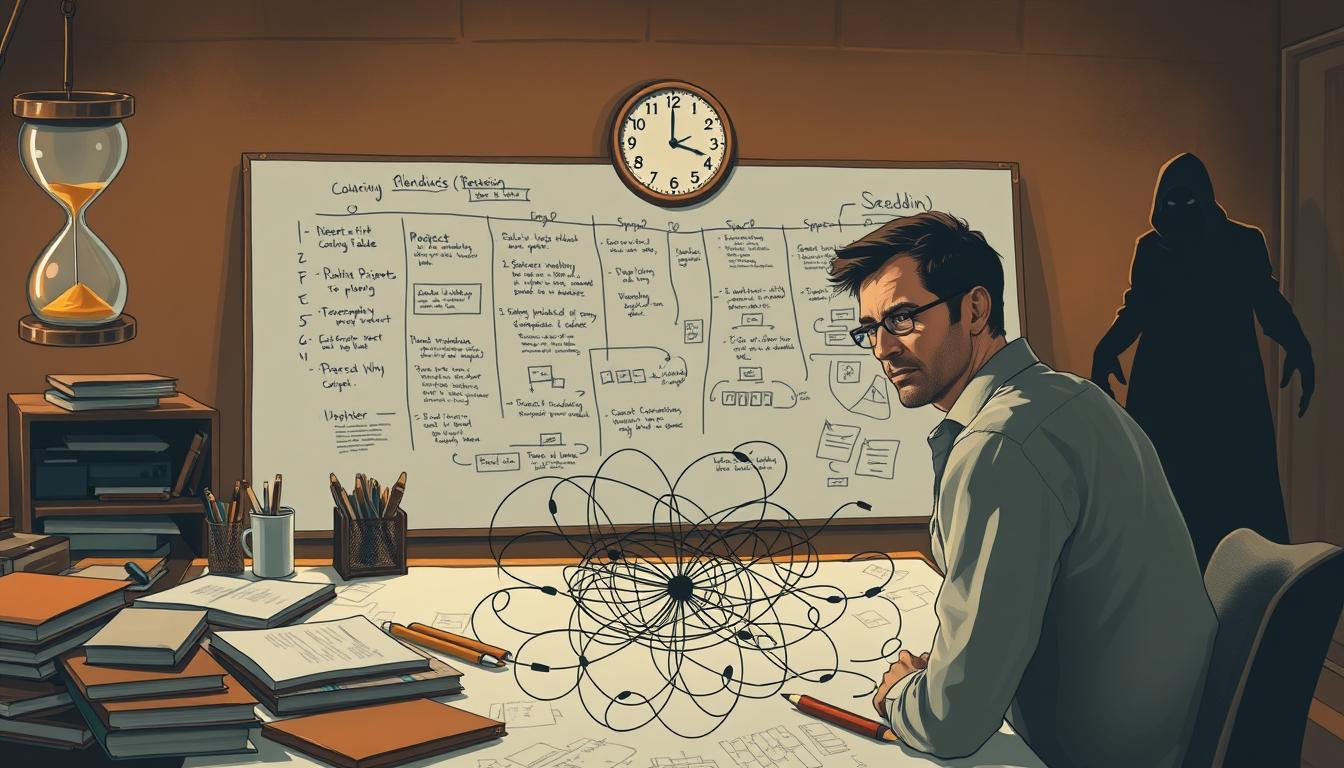Imagine you’re a soccer goalkeeper facing a penalty kick. Do you dive left, right, or stay put? Most likely, you’ll move, even if staying put might be smarter. This is the action bias mental model in action.
Why do we often choose to do something over waiting, even when waiting might be better?
The action bias mental model shows our preference for action over careful thought. Studies reveal people often act on impulse, thinking movement is progress. But this can lead to problems. Think of investors selling stocks during dips or managers approving risky plans to seem proactive.
Our brains think action means we’re competent, even when it’s not wise.
Key Takeaways
- Action bias is a mental shortcut pushing us to act instead of waiting
- Soccer goalkeepers statistically win fewer penalties by diving—yet 94% jump
- Business decisions often prioritize visible action over proven inaction strategies
- Action bias stems from evolutionary instincts to avoid perceived passivity
- Understanding this model helps avoid costly mistakes in personal and professional choices
Understanding the Action Bias Mental Model
The action bias mental model shows how we often choose to do something over waiting, even if waiting might be better. This isn’t just a small habit; it’s a big pattern in behavioral economics and psychology. Let’s explore why it happens and how it affects our choices.
Definition and Basic Concept
Imagine you’re facing a problem with no clear solution. You might feel the urge to act. That’s action bias at work. It’s linked to a basic survival instinct: doing nothing feels like failure, even when it’s the smarter choice.
A 2023 study found people often make choices based on habit, not careful thought. This leads to bad decisions.
Origins in Behavioral Economics
“Decisions are rarely made in a vacuum—they’re shaped by cognitive shortcuts we’re unaware of.”
Behavioral economists like Daniel Kahneman have shown how mental models like this bias affect our thinking. The action bias mental model thrives in situations where quick actions seem smart, even when they’re not. This is seen in markets, where traders might make trades just to look active, even if waiting could be better.
How Action Bias Affects Your Decisions
In everyday life, this bias might make you fix a problem with any action, without checking if it’s needed. For instance, a manager might change a team’s structure without solid data—just to seem like they’re doing something. Knowing this helps us see when patience is better than acting too quickly.
The Psychology Behind Our Tendency to Act
Ever wondered why you often feel the urge to act, even when waiting might be smarter? It all comes down to the psychology behind your choices. Human behavior is rarely alone, and bias often guides our decisions in certain ways.
Evolutionary Roots of Action Bias
Our ancestors had to make life-or-death choices every day. Quick action meant survival or finding food. Today, this instinct pushes us to act fast, even when it’s not the best choice.
Psychologists like Daniel Kahneman say our brains are wired for fast decisions. As we age, our ability to think on our feet may decline. But our ancient survival instincts keep urging us to move, not wait.
“Cognitive biases are mental shortcuts (known as heuristics) and they actually help us survive.”
Fear of Regret and Inaction
Think about missing a stock’s peak or not speaking up in a meeting. The fear of what could have been is stronger than the fear of acting rashly. This fear of inaction is deep-rooted.
Studies show that training can reduce this bias by 29%. Yet, many let fear of regret guide their choices. You might rush to act, even when patience would be better.
Social Pressure and the Perception of Productivity
In offices and social circles, doing something is seen as valuable. Managers who make quick decisions or coworkers who are always busy can make you feel like you need to keep up. This idea links productivity to being busy, not just results.
The psychology is clear: doing nothing feels like failure. Even when waiting could lead to better choices, it’s hard to resist the urge to act.
Common Examples of Action Bias in Everyday Life
Ever made a quick decision to avoid feeling stuck? That’s action bias at work. Imagine a soccer goalkeeper diving left during a penalty kick—“I have to do something!”—even though cognitive bias research shows staying put is better. This isn’t just sports—it’s a common pattern in human behavior we all see every day.

Think about times you’ve bought something “just in case” a sale ends, only to regret it later. Or hitting “reply all” in an email chain to seem busy, even when your input isn’t needed. These moments show how action bias makes us act without thinking if action is truly needed. Studies reveal over 200 cognitive biases, and action bias is one of the sneakiest.
In healthcare, we might choose immediate surgery over monitoring a minor issue, or switch phone plans monthly to “feel in control.” These decisions often ignore better long-term options. Even in traffic jams, changing lanes “just to do something” can make delays worse.
Why do we do this? Our brains prefer motion over calm, even when calm is smarter. Next time you feel the urge to “do something,” ask: Is this the best move, or just a reaction to uncertainty? That pause might be the wisest action of all.
When Action Bias Helps vs. When It Hurts
The action bias mental model is a double-edged sword. It can either push you forward or lead you astray, depending on the situation. Think of a fire—quick action can save lives. But in calm times, it might lead to costly errors.
| Helpful Situations | Harmful Situations |
|---|---|
| Responding to emergencies (e.g., first aid) | Overtrading stocks without research |
| Entrepreneurial risks (e.g., Andy Rouse’s 3D printing venture) | Medical overtreatment driven by fear of inaction |
| Learning through trial and error | Ignoring evidence to justify sunk costs |
Positive Applications of Action Orientation
Entrepreneurs like Andy Rouse (read his story here) show the power of action bias. In fast-paced worlds, quick decisions can turn chances into successes. For instance, trying new strategies helps you adapt quicker than waiting for perfect data.
The Dark Side: When Taking Action Backfires
The same heuristic can trap investors in overtrading or doctors in unnecessary procedures. Confirmation bias makes this worse: 40% of decisions made with 99% confidence are wrong. Overconfidence leads to ignoring warning signs, like chasing sunk costs in failing projects.
Finding the Right Balance Between Action and Patience
The aim isn’t to avoid action, but to use the action bias mental model wisely. Mix quick decisions with careful thought: pause to check data before acting. For example, a doctor might reconsider ordering extra tests to avoid doing nothing.
Action Bias in Professional Settings
In team leadership or project management, decision making under pressure often leads to hasty choices. Managers might opt for quick fixes without fully analyzing data. They assume that doing something is better than nothing. This bias thrives in places where visible activity is more valued than careful planning.
How Leaders Fall Into the Trap
Consider Netflix’s 2011 Qwikster split—a costly mistake made without testing user reactions to competition. Leaders under pressure to act might overlook better options. Even top athletes, like soccer goalkeepers, often jump during penalty kicks, despite the stats showing staying put is better. Research shows that 46% of business decisions are made out of urgency, not careful analysis.

Costs Hidden in the Hustle
Unnecessary action can waste resources. A North American insurer saved $30M yearly by switching to data-driven strategies instead of quick fixes. Tech firms like Apple also cut design cycles by 75% with structured processes. But, 34% of failed projects come from hasty decision making due to action bias. The solution? Take a moment to ask: “Does this action really serve our goals, or is it just a distraction?”
“Overcoming bias requires challenging assumptions daily,” say behavioral economists.
How to Recognize Your Own Action Bias Tendencies
Starting to recognize your action bias means looking inward. Ask yourself if you get anxious when you pause to think before acting. Or do you make quick decisions to seem decisive? These questions help uncover how cognitive bias influences your choices. It’s based on human behavior studied by experts like Amos Tversky and Daniel Kahneman.
“Even though there’s no single fix for cognitive biases, knowing when they happen is the first step to change.” – Behavioral Economics Research
| Common Triggers | Self-Check Questions |
|---|---|
| Feeling the need to “do something” without a plan | “Is this action based on facts or just discomfort with uncertainty?” |
| Seeing inaction as a failure | “Would I criticize someone else for waiting for more data?” |
| Valuing visible activity too much | “Does busyness equal effectiveness here?” |
Tests like Harvard’s Implicit Association Test (IAT) show hidden cognitive bias patterns. Even small delays, like waiting 24 hours, can stop automatic responses. Remember, it’s not about being perfect. It’s about making progress. Every time you pause to question your impulses, you’re moving toward more thoughtful choices.
Strategies to Overcome Harmful Action Bias
Breaking free from action bias starts with strategies that focus on clear decision making. When you face a big choice, take a moment to think. A 2020 study shows waiting 20-30 minutes after feeling strongly can help. This pause fights against biases that mess up our thinking.
Pause to Reframe Your Approach
Slow down by asking if your action fits your long-term goals. For leaders, this can stop costly mistakes—like 80% of failed mergers from hasty decision making. Use mindfulness to see inaction as a chance to observe. Also, consider getting outside advice to question your assumptions, as behavioral frameworks suggest.
Let Data Drive the Narrative
Make choices based on facts, not just feelings. Look at metrics like how much projects cost—only 16.2% of IT projects stay within budget. Use probability to think through options, asking for evidence. Feelings drive 80-90% of our choices, so balance them with data to avoid big mistakes.
Conclusion: Balancing Action and Thoughtful Restraint
Learning when to act and when to pause is key to mastering the action bias mental model. Behavioral economics shows that our urge to act isn’t always right.
Inaction isn’t failure. Sometimes, it’s the best choice. A smartphone giant cut design time by 75% with careful planning. A mental health platform saw a 52% user increase by redesigning based on insights.
Recognizing your action bias can help you make better choices. Tools like marginal cost analysis help you make informed decisions. It’s about choosing wisely for the long term, not just acting on impulse.
Think of this as upgrading your decision-making skills. Start by pausing before acting, asking for data, and focusing on outcomes. Your future self and business will appreciate it.


